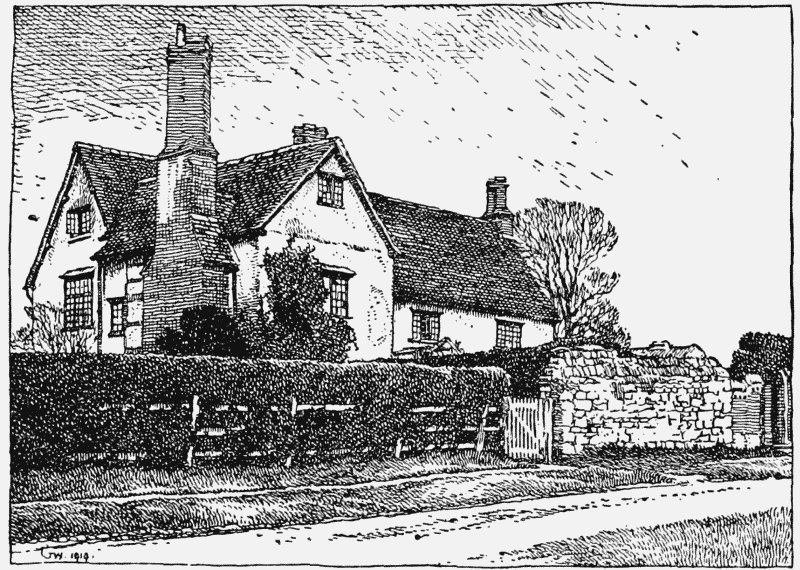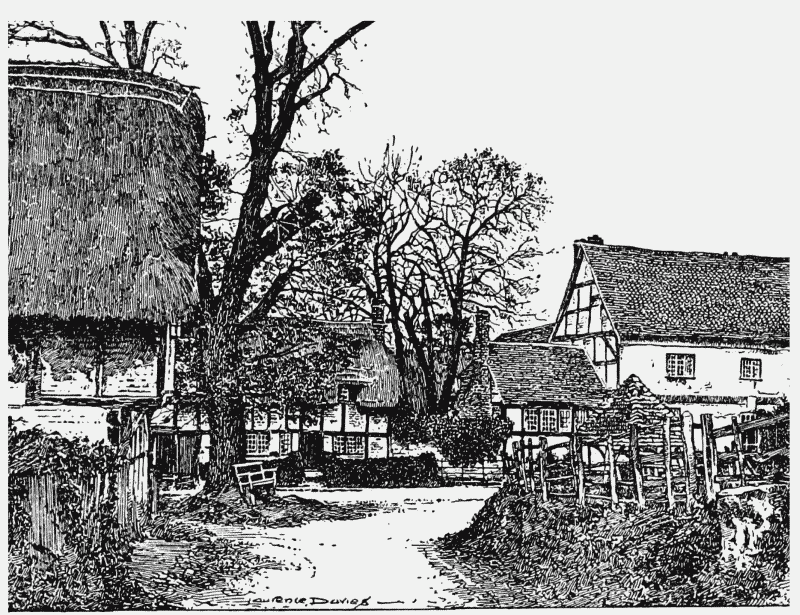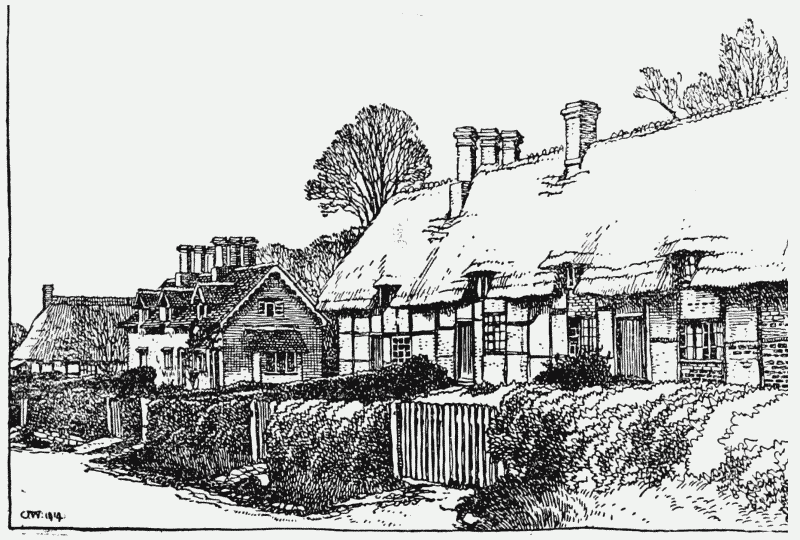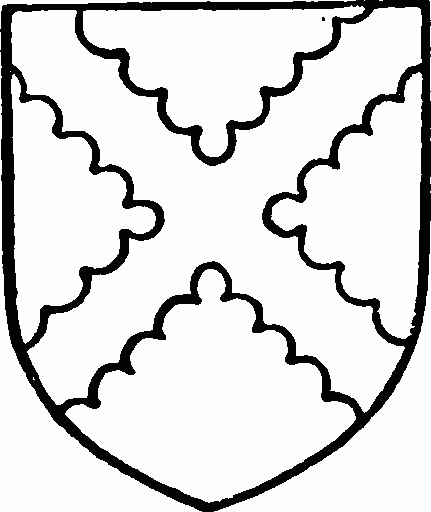A History of the County of Buckingham: Volume 4. Originally published by Victoria County History, London, 1927.
This free content was digitised by double rekeying. All rights reserved.
'Parishes : East Claydon', in A History of the County of Buckingham: Volume 4, ed. William Page (London, 1927), British History Online https://prod.british-history.ac.uk/vch/bucks/vol4/pp28-32 [accessed 23 April 2025].
'Parishes : East Claydon', in A History of the County of Buckingham: Volume 4. Edited by William Page (London, 1927), British History Online, accessed April 23, 2025, https://prod.british-history.ac.uk/vch/bucks/vol4/pp28-32.
"Parishes : East Claydon". A History of the County of Buckingham: Volume 4. Ed. William Page (London, 1927), British History Online. Web. 23 April 2025. https://prod.british-history.ac.uk/vch/bucks/vol4/pp28-32.
In this section
EAST CLAYDON
Claindone (xi cent.); Estcleydone (xiii cent.).
This parish contains 2,395 acres, including 1,936 acres of permanent grass and 181 acres of arable land. (fn. 1) The slope of the land above the ordnance datum varies from 295 ft. in the east of the parish to 407 ft. in the south-west, the soil being rich clay loam; the subsoil clay and gravel. Wheat, beans, roots and oats are grown, but the chief industry is dairy farming. Pillow-lace was still made by women and children in East Claydon in 1862. (fn. 2) Grandborough Road station on the Metropolitan Extension railway and Winslow Road station on the Metropolitan railway are within the borders of this parish.
The village of East Claydon is situated on rising ground towards the north-west of the parish. White House Farm, the old manor-house, stands on a moated site near the church to the north. The oldest part dates probably from the end of Elizabeth's reign. The house stands east and west, with a wing at right angles at the south-west, in which is a good stone bay window with moulded mullions and transoms. The walls are in part of half-timber work and in part of brick and stone. The south front has an overhanging story with a plastered cove and moulded beams, and an added stone-faced porch of 17th century date with a flat-arched entrance under a square head, flanked by fluted pilasters. The inner doorway is of oak with a moulded frame, and retains its old door. In one of the rooms is a stone arched fireplace. To the north-west of the church is a house of about the same date, to which a stone front was added in 1675, the date being on a stone panel over the south doorway, with the initials EVM and a shield. A wing was added at the back of the house in the 18th century. At the corner of the road leading to Botolph Claydon is a picturesque L-shaped house of about 1600, timber framed, with later brick facing. The upper story of the east gable end overhangs, the projecting beams having curved brackets beneath.

The White House, East Claydon
Half a mile south-west of East Claydon is the village of Botolph Claydon (Botteclaydon, xiii cent.; Botteleclaydon, xiv cent.), with Botolph House, a substantial brick and stone manor-house, the residence of Mrs. Verney, at its east end. Botyl Well, commonly corrupted into St. Botolph's Well, is reached by steps at its south-west end.
In this village are a number of small 17th-century timber-framed houses, mostly with red brick chimney-stacks, the most interesting one being at Bernwood Farm. It has closely set upright timbers, and is probably not later than about 1600; a wing was added in the 18th century. Claydon Mill appears to have stood in Botolph Claydon. (fn. 3)
Manors
In 1086 Miles Crispin held 7 hides 3 virgates of land in EAST CLAYDON as one manor. (fn. 4) This land was attached to the honour of Wallingford, (fn. 5) and with it transferred to the honour of Ewelme. (fn. 6) The last reference to this overlordship in East Claydon occurs in 1572. (fn. 7)
Miles Crispin had subinfeudated his manor in Claydon (fn. 8) before 1086 to Geoffrey. (fn. 9) This mesne overlordship had passed before 1234 to Peter de la Mare, (fn. 10) before 1302 to Robert de la Mare, (fn. 11) and by 1312 to Robert's son and heir Peter. (fn. 12) In 1346 it was appurtenant to the manor of Aylesbury, (fn. 13) and later in the century it was held by the Earl of Warwick, the last reference to it occurring in 1375. (fn. 14)
Part of the Crispin manor in Claydon was split up and descended with neighbouring manors; the remainder corresponds to the land which passed in the later 12th century in marriage with Maud de la Mare. (fn. 15) In 1199 her second husband, Giles de Pinkeny, surrendered his claim to hold it for life to her son William de Englefield. (fn. 16) This land was evidently the half-fee held in the middle 13th century by Robert de Wimbervill, (fn. 17) since his kinsman, Roger de Wimbervill, was exempted from this service in 1248 by William de Englefield in exchange for a yearly rent of 46s. 8d. (fn. 18) Part of this land must have passed to Thomas de Valognes and formed part of the 13 virgates held by Robert de Grey in East Claydon in 1284. (fn. 19) His widow Joan de Valognes was holding the half-fee with a separate estate of 2 hides (see below) in 1302. (fn. 20) These, with 4 virgates of land of the honour of Peverel (see below) formed CLAYDON or EAST CLAYDON MANOR, of which Joan's grandson and heir John, Lord Grey of Rotherfield, died seised in 1359. (fn. 21) Until 1477 it descended with the manor of Shabbington, and afterwards with the secondary overlordship there, until 1543, (fn. 22) when it was sold by Henry Parker, Lord Morley, to Thomas King. (fn. 23) Thomas Lee of Moreton died seised of East Claydon Manor in 1572. (fn. 24) His son and heir Thomas, (fn. 25) afterwards Sir Thomas Lee, kt., sold it in 1624 to William Abel. (fn. 26) His son William Abel (fn. 27) succeeded before 1659, (fn. 28) and died while sheriff for the county in 1661. (fn. 29) His daughter and heir Mary married Edmund Verney, eldest son of Sir Ralph Verney, the first baronet. (fn. 30) She survived her husband and their children, and on her death in 1715 (fn. 31) East Claydon Manor passed to a cousin, William Abel. (fn. 32) In 1722 his children, Richard and Bridget Abel, (fn. 33) surrendered their interests in it to Messrs. Paltock & Snow, (fn. 34) and in 1728 it was purchased by Ralph Viscount Fermanagh. (fn. 35) It has since passed with Middle Claydon (q.v.), and Sir Harry Calvert Verney, bart., is the present owner.

The Village, East Claydon

Botolph Claydon Village

Lee of Moreton. Azure two bars or with a bend checky or and gules over all.

Abel. Argent a saltire engrailed azure.
A manor of 7 hides in East Claydon, CLAYDON or BOTOLPH CLAYDON MANOR, was held before the Conquest by Suen, a man of Ansgar the Staller. (fn. 36) In 1086 it was held by Geoffrey de Mandeville. (fn. 37) The overlordship in the earldom of Hereford is traceable in the 13th century. (fn. 38) A mesne overlordship descended in the Fitz John (Fitz Geoffrey) family, (fn. 39) and was appurtenant in 1346 to the manor of Aylesbury (fn. 40) (q.v.).
Botolph Claydon had been subinfeudated to Thomas de Valognes in the middle 13th century, (fn. 41) and passed by the marriage of his daughter and heir Joan to Robert de Grey. (fn. 42) It descended with East Claydon Manor (q.v.), but its identity as a second manor was not recognized in the confirmation of the sale in 1624. A grant of free warren in East Claydon and Botolph Claydon was made to John de Grey in 1330. (fn. 43)
In 1086 William Peverel held 3 hides 1 virgate of land in [East] Claydon as a manor which had been formerly held by Alwin, one of King Edward's thegns. (fn. 44) The overlordship belonged to the honour of Peverel and is traceable in East Claydon until the end of the 14th century. (fn. 45)
William Peverel's manor in East Claydon was subinfeudated to Ralph in 1086. (fn. 46) In the middle 13th century Ralph son of Ralph de Quarrendon held the land by the serjeanty (fn. 47) of finding a horse, haversack and pack-saddle for the king when on expedition to Wales, and transferred it to Thomas de Argentein. (fn. 48) Subinfeudation had already begun. Nine virgates held at this time by Ralph de Quarrendon, (fn. 49) traceable in part as descending in his family and that of the Wades, (fn. 50) correspond to the land in East Claydon alienated in 1345 to Studley Priory by John Frelond and William atte Wood. (fn. 51) The priory lands here, valued at 40s. yearly in 1535, (fn. 52) were granted in 1540 to John Croke, (fn. 53) who did not retain them. (fn. 54) They, together with a messuage called Pontifex, were purchased from Arthur King by Simon Love, who died seised in 1574 (see advowson). In the 17th century the priory farm, evidently part of this estate, was under the same ownership as East Claydon Manor. (fn. 55) The remaining 4 virgates of land, part of which was held by Richard de Argentein in the 13th century, (fn. 56) and conveyed by him in 1250 to Thomas de Valognes, (fn. 57) appear in 1359 as part of East Claydon Manor (q.v.).
Miles Crispin held 2 hides of land in Claydon in 1086, retaining as tenants two Englishmen formerly Harning's men. (fn. 58) This land was held by Thomas de Valognes in the middle 13th century, and afterwards formed part of East Claydon Manor (fn. 59) (q.v.).
Church
The church of ST. MARY THE VIRGIN consists of a chancel 26 ft. by 14 ft. 6 in., with a modern north vestry, a nave 47 ft. 6 in. by 22 ft., with a south chapel 18 ft. 6 in. by 9 ft. 6 in., and a modern north aisle and south porch, and a west tower 11 ft. by 10 ft. These measurements are all internal.
The earliest part of the church, which at the beginning of the 13th century consisted of an aisleless nave and chancel, is the western half of the south wall of the nave. No details, however, of earlier date than the 13th century are to be seen. The south chapel was added to the nave about 1230, and the chancel was rebuilt about 1350. Towards the end of the 15th century, or a little later, the nave was widened northwards, thus being thrown out of centre with the chancel, while the tower, which is on the same axis as the nave, seems to have been added at the same time. The clearstory of the nave also belongs to this time, but owing to the rebuilding of the north wall when the modern north aisle was added, only the south side now remains.
The chancel is ashlar-faced and has a modern east window and two windows in the north wall, of which the western is much-repaired 14th-century work of two trefoiled lights with tracery, and the eastern a modern copy of it, retaining only a few old stones in its jambs to show that it represents an original window. Between them is a 14th-century doorway with fourleaved flowers in the head and jambs, now opening to the modern vestry, which overlaps the western window. The two windows in the south wall of the chancel are modern copies of the others. In the north wall of the chancel is a modern recess, containing the 14th-century jambs of what was doubtless a piscina, ornamented with rosettes and four-leaved flowers. The weathering of a steep-pitched roof, coeval with the chancel, shows on the east face of the east gable of the nave, but the present chancel roof is of low pitch, having a wagon-headed ceiling with egg and tongue ornament of the 17th century on its ribs. The chancel arch, which is of the date of the chancel, is of two chamfered orders, the inner order springing from corbels carried by grotesque winged figures.
The nave has a modern north arcade of three bays, but in the wall to the west of it is a much-restored lancet window, of which part is doubtless of 13th century date, and the wall in which it is set, like the south wall of the nave, may be older. In the modern north aisle a late 15th-century doorway has been reset near the east end of the north wall; it has a four-centred head and tracery in the spandrels. At the south-east angle of the nave the upper doorway of the rood-stair remains, with part of the stair, opening from the south chapel; the shouldered head of the doorway is not original. The south chapel opens to the nave by a plain pointed 13th-century arch with an indented label, and to the east of it is an opening from the chapel, of 15th-century date, made for the double purpose of giving a view of the chancel from the chapel and of lighting the nave altars; its west jamb is splayed outwards to command a wider view to the eastward. The chapel is lighted by five lancet windows, two on the east, two on the south, and one on the west, all with internal rebates for the glazing frames. In the south wall is an original piscina recess with a shouldered head. The south doorway of the nave is plain 13th-century work of a single order, and west of it is an uncusped two-light window, nearly all modern. Of the nave clearstory only the south side remains, with two square-headed windows of three cinquefoiled lights. The nave roof, of contemporary date, is low pitched and of plain character.
The tower is of three stages, ashlar-faced, with a stair turret at the south-west; the tower arch is of two chamfered orders, the inner order dying at the springing. The west doorway has a four-centred arch under a square head, and over it is a window of three cinquefoiled lights. In the second stage there is only one opening, a round-headed light in the north wall, while in each face of the third stage are two uncusped openings with square heads. There is an embattled parapet and flat leaded roof.
The plain octagonal font is of the 15th century. There are no other ancient fittings, but a small 17th century communion table is preserved in the vestry.
In the chancel floor is the grave slab of William Abel, 1661, lord of the manor and sheriff in the year of his death. In the churchyard is a slab with the indent of a cross-brass.
There is a ring of five bells, all by Abel Rudhall, 1752. The sanctus bell, dated 1657, is probably by Anthony Chandler.
The plate includes a cup and cover of 1569.
The registers begin in 1584.
Advowson
The church of East Claydon, valued at £6 13s. 4d. in 1291, (fn. 60) is mentioned in 1312 (fn. 61) as appurtenant to the land afterwards distinguished as Botolph Claydon Manor (q.v.). It descended in the Greys, (fn. 62) and was granted by John Lord Grey of Rotherfield (fn. 63) in 1371 to Bisham Priory, with licence to appropriate the church. (fn. 64) The Crown grant was ratified in 1409, (fn. 65) and a vicarage was ordained in 1421. (fn. 66) In the next century the advowson, valued at £8 yearly in 1535, (fn. 67) had passed with the rectory to the Knights Hospitallers. (fn. 68) The advowson was granted in 1551 to Lord Clinton (fn. 69) and transferred to William King, who presented in that year. (fn. 70) Later in the century it was sold by Arthur King to Simon Love, who died seised in 1574 during the minority of his son and heir John. (fn. 71) Pardon for alienation to his executors in trust was granted in 1579. (fn. 72) His widow married John Morgan Wolfe, and they with John Love, who attained his majority in 1587, (fn. 73) sold East Claydon advowson in the same year to Robert Hoveden (fn. 74) (or Hovenden). Robert Hoveden was succeeded by his nephew Robert Hoveden in 1613. (fn. 75) After 1680 (fn. 76) East Claydon advowson passed to two daughters and co-heirs, (fn. 77) one of whom, Diana, married Count Fieschi. (fn. 78) They conveyed it in 1726 to Ralph Verney, (fn. 79) who retained it. (fn. 80) From 1752, when he succeeded as Earl Verney, this advowson has descended with Middle Claydon (fn. 81) (q.v.), and the present owner is Sir Harry Calvert Williams Verney, bart.
In 1821 the vicarage of East Claydon was united with that of Steeple Claydon to the rectory of Middle Claydon, (fn. 82) and this union has continued in respect of East Claydon.
The rectory of East Claydon was granted in 1549 to George Wright and Eustace Moon. (fn. 83) Sir Robert Lane was seised of it in 1568, when he leased it to William King for twenty-one years. (fn. 84) Six years later he sold the reversion to Alexander Denton, (fn. 85) and some of the tithes descended to his son Sir Thomas Denton. (fn. 86) In 1666 the rectory is named as in the possession of John Duncombe. (fn. 87)
William Spyrke, of Botolph Claydon, in his will dated 10 January 1451, left two sheep for the lights of St. Mary and the Holy Cross in the church of East Claydon. (fn. 88) A light was maintained in 1548 from the rent (2d. yearly) of half an acre of land in East Claydon. (fn. 89) This land was granted in 1586 to John Walton and John Cresset. (fn. 90)
Charities
The following charities were consolidated by a scheme of the Charity Commissioners of 17 January 1913, namely: William Abel's charity, founded before 1721, consisting of a rent-charge of £4 Maurice Griffiths' charity, will 1673, consisting of a rentcharge of £2 and the Town stock, being an annuity of £1 12s. supposed to represent a gift of £34 by a donor unknown. These annuities, amounting together to £7 12s., are paid out of an estate at East Claydon now in the possession of Sir Harry Verney, bart., and are applied in the distribution of money among poor families, poor labourers, and a portion for the benefit of the sick and needy. (See also under Middle Claydon.)